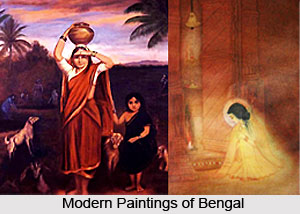Bengali renaissance
Bengal Renaissance refers to the beginning of the transition to a modern society of Bengal. Most of the beginning is set in the 19th century, a period of cultural, social, religious, intellectual, and political change. Center of the movement was Kolkata.
Comparable to the time of the European Renaissance, there was a re-interpretation of classical texts ( Vedas, Upanishads ) in the sense of an aligned on the autonomic, gifted with reason philosophy of the subject. With the establishment of modern educational facilities and the introduction of new, predominantly Western culture taken from educational content as well as the new economic opportunities through cooperation with the British East India Company and later the British colonial administration, a new, mostly consisting of the upper caste society layer bhadralok was. This layer provided the intellectual monopoly of the traditional elite, as well as social and religious traditions in question. They sought the establishment of a bourgeois public (schools, libraries, clubs), a modern economy (trade, industry, banking ) and to social and religious reform ( women's rights ). The Bengali language and literature flourished. With the increasing urbanization and industrialization, the working world and modern concepts of time and discipline changes were anchored.
In contrast to the Renaissance in Europe, these formation processes of a modern society took place in Bengal under colonial conditions. This meant in particular that Bengal and increasingly integrated across India as a raw material supplier and sales market in the then world capitalist economy and the emergence of an indigenous entrepreneurship on the part of the colonial power was disabled. The resulting middle class was mainly west educated and oriented and dependent in their existence by the colonial structures. Various measures of the colonial government (strengthening of the aristocracy, solidification of the box structures, codification of patriarchal relations ) promoted a traditionalization society.
In the last third of the 19th century, the vague hopes of the educated elite to social progress in cooperation with the colonial power and the Renaissance faded connects, similar to the Risorgimento in Italy, with the idea of a national awakening and the call for a national culture.
Critics complain that the Bengal Renaissance was limited to an elite minority and the majority of the Bengali population remained unaffected by this period of change. It also denies the Bengal Renaissance is a mere imitation of Western ideas, is sometimes raised. Contemporaries spoke rather of a time of awakening, but after 1880, the term became common a Bengal Renaissance. Despite all the weaknesses that are found to some extent in the European counterpart, you can see the Bengali Renaissance as a powerful indigenous movement in which a range of groups and individuals worked, who the Bengali and beyond Indian society and culture changed.
Some leading personalities and groups
- Brahmo Samaj
- Henry Louis Vivian Derozio (1809-1831)
- Ishwarchandra Vidyasagar (1820-1891)
- Debendranath Tagore (1817-1905)
- Bankim Chandra Chattopadhyay (1838-1894)
- Rabindranath Tagore (1861-1941)
- Vivekananda (1863-1902)
- Sharat Chandra Chattopadhyay (1876-1938)










